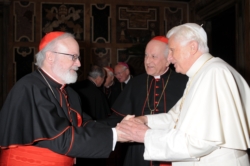From Cardinal Seán’s blog
This week I traveled to Rome to attend the plenary meeting of the Congregation for Institutes of Consecrated Life and Societies of Apostolic Life, of which I am a member.
The main theme for the meeting was monastic life and its significance in the Church and the world today.
At the meeting, we tried to address some of the issues and challenges that monastic communities are facing. In Europe and North America we are facing a decline in the number of vocations as well as the progressive aging of monks and nuns. At the same time there are signs of hope. For instance, I met there a young Cistercian nun who is the superior of a flourishing community in Denmark. Also, in other parts of the world like Asia, Africa and Latin America, vocations to monastic life are growing.
Currently, there are 12,876 monks living in 905 monasteries and 48,493 contemplative nuns living in 3,520 monasteries, two-thirds of which are found in Europe. Spain has, by far, the most of any country.
During the plenary meeting, Cardinal Franc Rode, who is the prefect of the Congregation, told us how fondly he remembered his trip to Boston in September and the Symposium on Religious Life he attended at Stonehill College.
One of the highlights of the trip was the Congregation’s audience with the Holy Father on Thursday. The audience was at the Sala Clementina or Clementine Hall, which is a magnificent hall inside the Vatican, where the pope holds his larger audiences. The ceiling is two stories high and was built by Pope Clement VIII.
Another highlight of the trip was a visit to my titular church in Rome, Santa Maria della Vittoria, or Our Lady of the Victory.
The Carmelite Fathers who operate the church arranged for me to celebrate Mass there Sunday. Though it is a magnificent church, it is fairly small, so it was filled to capacity.
After the Mass, the Capuchin provincial invited us to visit the Capuchin Church of the Immaculate Conception.
The Church and convent, which is located in Via Vittorio Venetto, was built by a Capuchin cardinal, Cardinal Antonio Barberini, who was the brother of Pope Urban VIII. The church, built in the 17th century, is the first in Rome that was named for the Immaculate Conception of Mary.
It is a very historical church, but it is mostly known because of its crypt-ossarium, a capuchin cemetery, that contains the skulls and skeletons of nearly 4,000 capuchin friars buried there between 1528 and 1870.
On Thursday, after the audience with the Holy Father, we had Mass in the Chapel of the Madonna of Partorienti. The chapel is in one of the grottoes underneath St. Peter’s Basilica very near the tomb of St. Peter. I offered for the people of Boston and particularly for God’s blessing upon us on this Bicentennial year.



















